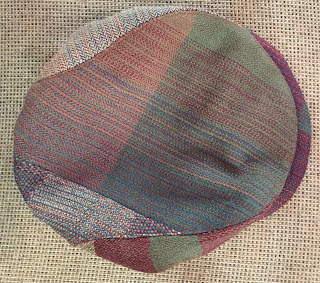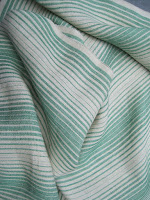 |
| sarah's crochet hat |
Hats are a great small project that can be made without a big investment in materials or time. Everyone can use a hat so it is not a problem if you get on a roll and make too many. You can wear different hats to suit your mood. You can give them as gifts or donate them. Or if you really made too many you can sell them at a craft fair.
Styles, construction methods and materials vary. The hat in the photo was crocheted. It is a composite of bits and bobs of wool and wool/mix yarns. The stitching forms expanding rows of blobs. The ear flaps and ties are hidden underneath.
 |
| tam with beads |
The second hat uses the same theme of expanding circles using different yarns. In some places beads have been incorporated into the kniting. This one takes the form of a "tam". It is a good example of using up those tiny bits of yarn that you can't throw out. Sort them into a colour scheme, pick one and just knit until it runs out then add another at random until the hat is big enough.
 |
| Sylvia's stash busting hat |
With a little more yarn you can make a classic toque with cables. If Sylvia's stash busting hat is more your style, you can learn how to knit in the round and produce something similar by taking one of our knitting workshps. Check out "workshops".
For a practical hat that is stylish, warm and almost water proof you can't beat a wool hat that has been felted.
 |
| Sylvia's felted knit hats |
The picture to the left show four knitted hats that have been wet finished to felt them then they were shaped to create different styles. The elegant red/green hat was created directly from dyed wool that was layered then wet felted and shaped to form a cloche.
 |
| David's wet felted wool hat |
 |
| Tam and scarf of hand spun wool |
If you are a spinner you will appreciate the work involved in the tam with matching scarf. Look carefully at the photo and you can see the slight variation that suggests the yarn was hand-spun. The yarn and stitching are quite fine.
 |
| Mary's hat sewn from cloth scraps |
You don't have to be a knitter to create a unique hat. The cap in the photo was sewn from scraps of hand-woven fabric. The different scraps were woven from fine wool yarns that share colour families so they work together to create an interesting combination.
.JPG) |
| making a statement hat |
And finally we have the "make a statement" hat or the I've got yarn and a crochet hook and an imagination. It looks warm too.














.JPG)